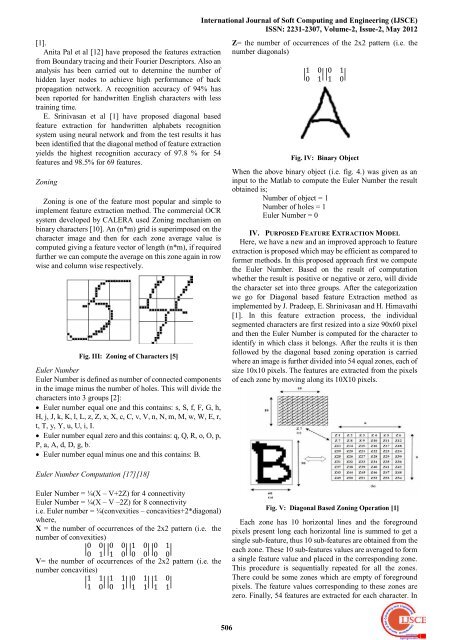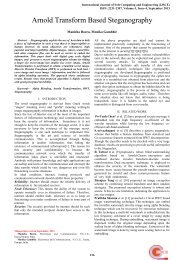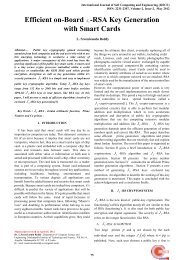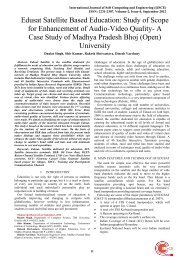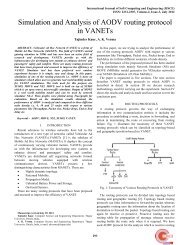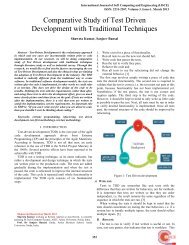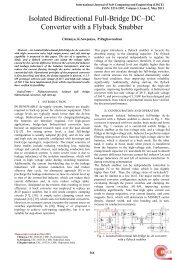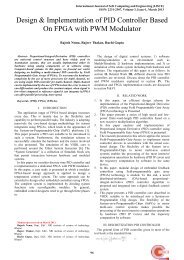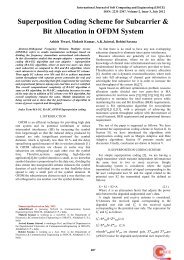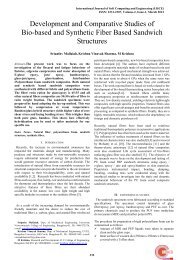An Improved Zone Based Hybrid Feature Extraction Model for ...
An Improved Zone Based Hybrid Feature Extraction Model for ...
An Improved Zone Based Hybrid Feature Extraction Model for ...
You also want an ePaper? Increase the reach of your titles
YUMPU automatically turns print PDFs into web optimized ePapers that Google loves.
[1].<strong>An</strong>ita Pal et al [12] have proposed the features extractionfrom Boundary tracing and their Fourier Descriptors. Also ananalysis has been carried out to determine the number ofhidden layer nodes to achieve high per<strong>for</strong>mance of backpropagation network. A recognition accuracy of 94% hasbeen reported <strong>for</strong> handwritten English characters with lesstraining time.E. Srinivasan et al [1] have proposed diagonal basedfeature extraction <strong>for</strong> handwritten alphabets recognitionsystem using neural network and from the test results it hasbeen identified that the diagonal method of feature extractionyields the highest recognition accuracy of 97.8 % <strong>for</strong> 54features and 98.5% <strong>for</strong> 69 features.ZoningZoning is one of the feature most popular and simple toimplement feature extraction method. The commercial OCRsystem developed by CALERA used Zoning mechanism onbinary characters [10]. <strong>An</strong> (n*m) grid is superimposed on thecharacter image and then <strong>for</strong> each zone average value iscomputed giving a feature vector of length (n*m), if requiredfurther we can compute the average on this zone again in rowwise and column wise respectively.Fig. III: Zoning of Characters [5]Euler NumberEuler Number is defined as number of connected componentsin the image minus the number of holes. This will divide thecharacters into 3 groups [2]: Euler number equal one and this contains: s, S, f, F, G, h,H, j, J, k, K, l, L, z, Z, x, X, c, C, v, V, n, N, m, M, w, W, E, r,t, T, y, Y, u, U, i, I. Euler number equal zero and this contains: q, Q, R, o, O, p,P, a, A, d, D, g, b. Euler number equal minus one and this contains: B.Euler Number Computation [17][18]International Journal of Soft Computing and Engineering (IJSCE)ISSN: 2231-2307, Volume-2, Issue-2, May 2012Z= the number of occurrences of the 2x2 pattern (i.e. thenumber diagonals)1 00 10 11 0Fig. IV: Binary ObjectWhen the above binary object (i.e. fig. 4.) was given as aninput to the Matlab to compute the Euler Number the resultobtained is;Number of object = 1Number of holes = 1Euler Number = 0IV. PURPOSED FEATURE EXTRACTION MODELHere, we have a new and an improved approach to featureextraction is proposed which may be efficient as compared to<strong>for</strong>mer methods. In this proposed approach first we computethe Euler Number. <strong>Based</strong> on the result of computationwhether the result is positive or negative or zero, will dividethe character set into three groups. After the categorizationwe go <strong>for</strong> Diagonal based feature <strong>Extraction</strong> method asimplemented by J. Pradeep, E. Shrinivasan and H. Himavathi[1]. In this feature extraction process, the individualsegmented characters are first resized into a size 90x60 pixeland then the Euler Number is computed <strong>for</strong> the character toidentify in which class it belongs. After the reults it is thenfollowed by the diagonal based zoning operation is carriedwhere an image is further divided into 54 equal zones, each ofsize 10x10 pixels. The features are extracted from the pixelsof each zone by moving along its 10X10 pixels.Euler Number = ¼(X – V+2Z) <strong>for</strong> 4 connectivityEuler Number = ¼(X – V –2Z) <strong>for</strong> 8 connectivityi.e. Euler number = ¼(convexities – concavities+2*diagonal)where,X = the number of occurrences of the 2x2 pattern (i.e. thenumber of convexities)0 00 10 0 1 0 0 11 0 0 0 0 0V= the number of occurrences of the 2x2 pattern (i.e. thenumber concavities)1 1 1 1 0 1 1 01 0 0 1 1 1 1 1Fig. V: Diagonal <strong>Based</strong> Zoning Operation [1]Each zone has 10 horizontal lines and the <strong>for</strong>egroundpixels present long each horizontal line is summed to get asingle sub-feature, thus 10 sub-features are obtained from theeach zone. These 10 sub-features values are averaged to <strong>for</strong>ma single feature value and placed in the corresponding zone.This procedure is sequentially repeated <strong>for</strong> all the zones.There could be some zones which are empty of <strong>for</strong>egroundpixels. The feature values corresponding to these zones arezero. Finally, 54 features are extracted <strong>for</strong> each character. In506


